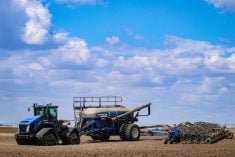Glacier FarmMedia—Overall spring seeding of all crops in Alberta was just over 18 per cent complete, according to the province’s first crop report of 2024. The pace was nearly seven points above the five-year average.
The report, produced by the Agriculture Financial Services Corporation, noted that planting very likely started in mid-April. The south was furthest along at almost 40 per cent complete, with Peace River about 18 per cent, the central at 14 per cent, the northwest a pinch below four per cent and northeast short of three per cent.
Read Also

U.S. grains: Soybeans rise on China demand hopes; corn and wheat rebound
Chicago Board of Trade soybean, corn and wheat futures rose on Monday on signs of progress towards the end of a record-long U.S. government shutdown, along with expectations of a revival of U.S. soybean exports to China, analysts said.
In terms of crops, potatoes were well ahead of all the others at 61 per cent planted. Durum led the cereals at almost 47 per cent, followed by spring wheat at 23 per cent, with barley just short of 19 per cent and oats at five per cent.
The pulses were led by lentils at nearly 39 per cent planted, with dry peas very close behind at 38 per cent, while chickpeas were a distant third at less than 14 per cent.
Among the oilseeds, mustard rated more than 35 per cent in the ground, with flax at less than 19 per cent and canola short of six per cent.
Corn planting was at 32 per cent complete.
In terms of winter crops, the report cited those in the central at 77 per cent good to excellent and the south at 59 per cent. No other regions were listed for winter crops.
Alberta’s surface soil moisture ratings were almost eight per cent poor, over 28 per cent fair, more than 55 per cent good, about eight per cent excellent and less than one per cent excessive.
By region Peace River ranked nearly 53 per cent poor to fair compared to just over 47 per cent good to excellent, while the south was around 40 per cent poor to fair versus nearly 60 per cent good to excellent. The central came in at more than 42 per cent poor to fair compared to almost 58 per cent good to excellent. The northeast was less than 22 per cent poor to fair as opposed to 76 per cent good to excellent. The northwest was over 14 per cent poor to fair versus more than 84 per cent good to excellent.
While there has been less soil erosion due to spring runoff, there has been a little bit more wind erosion.













